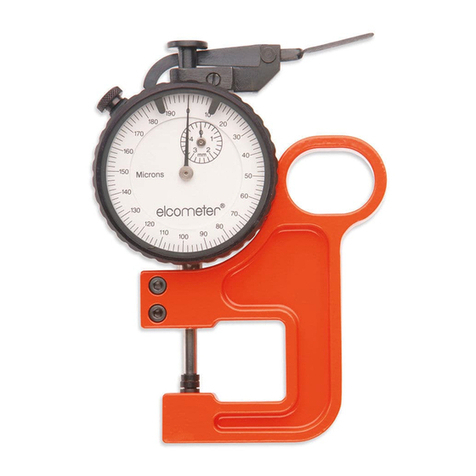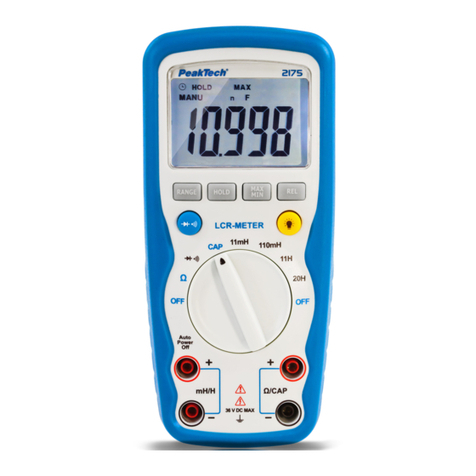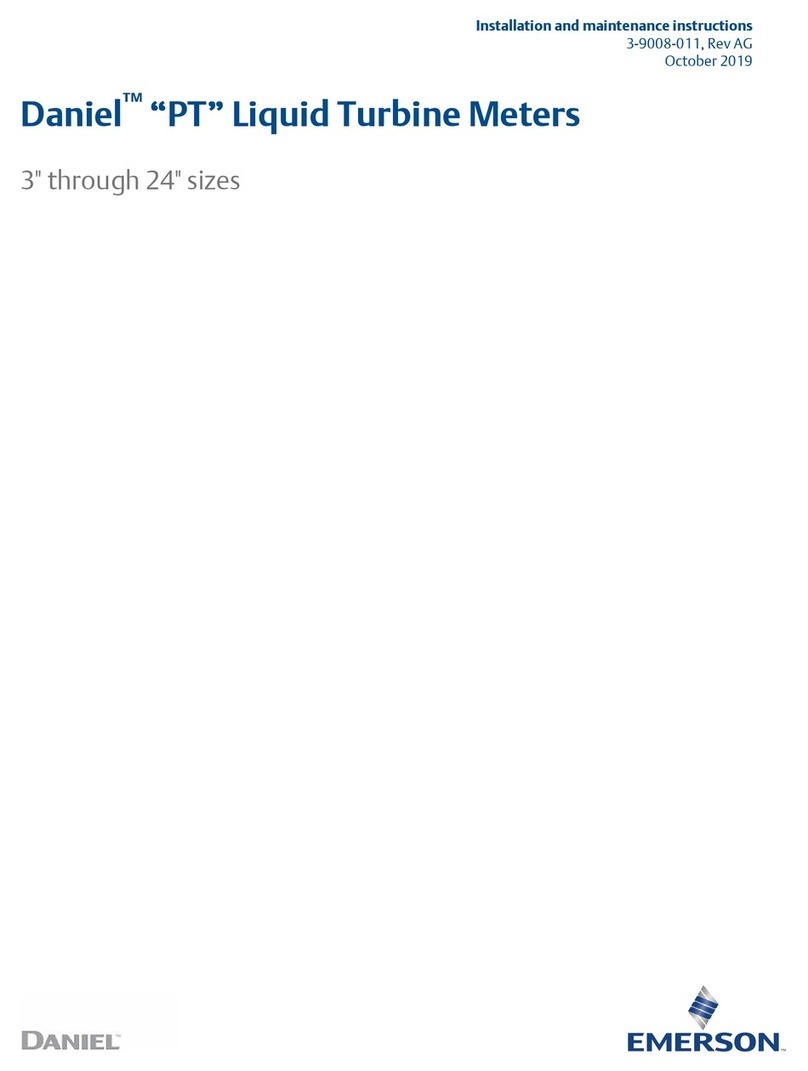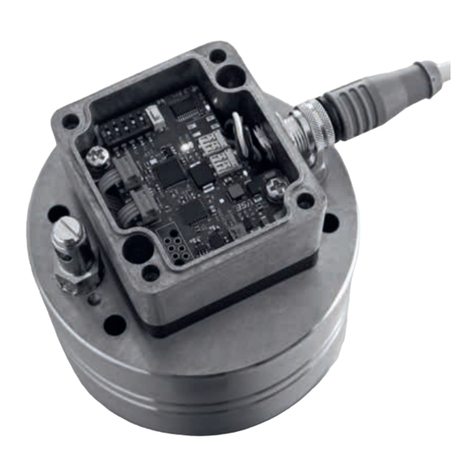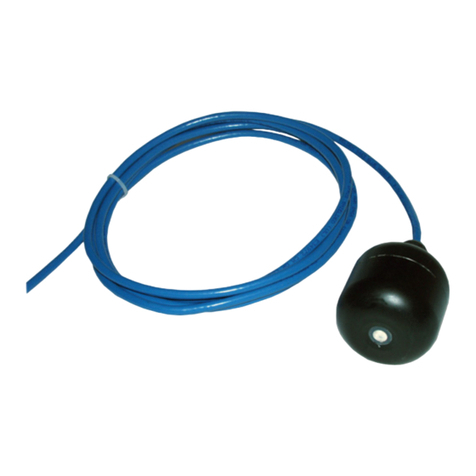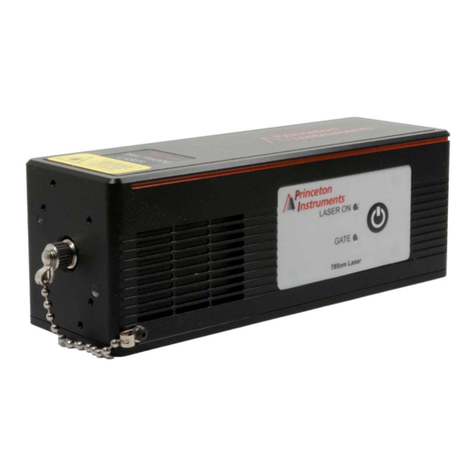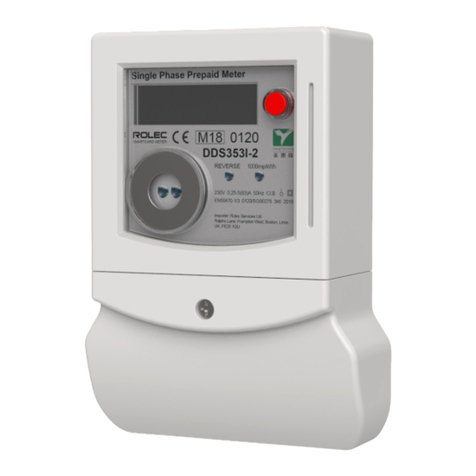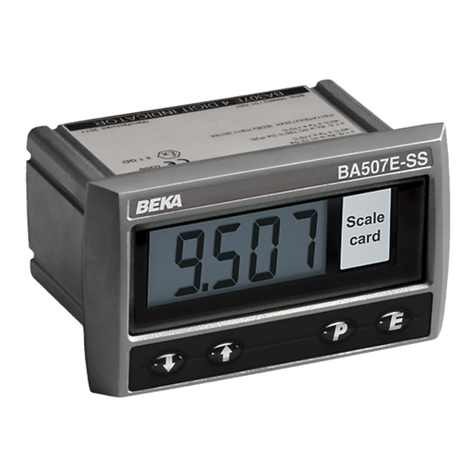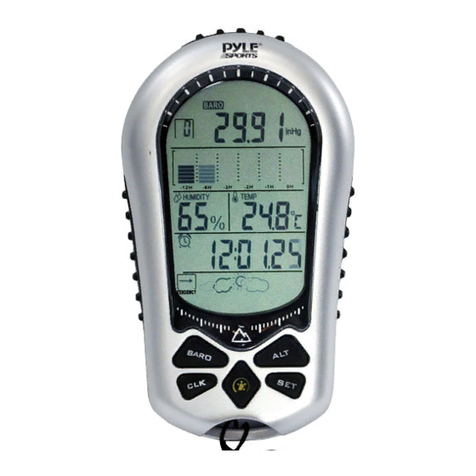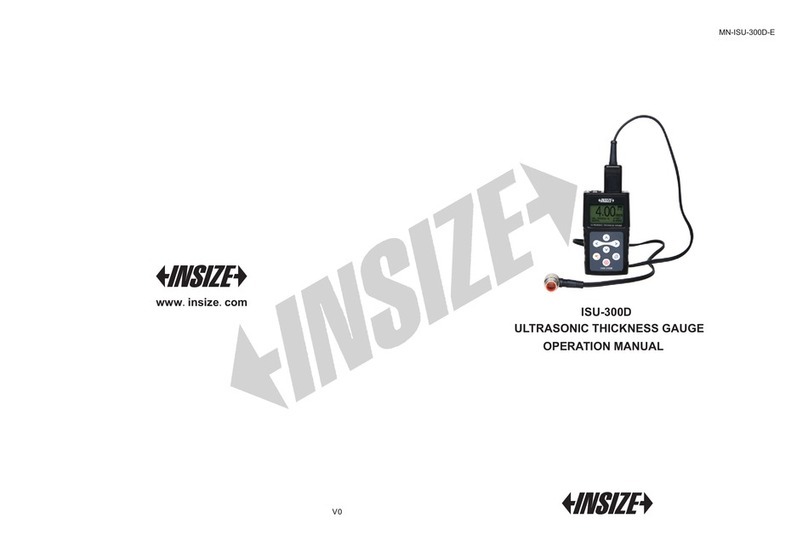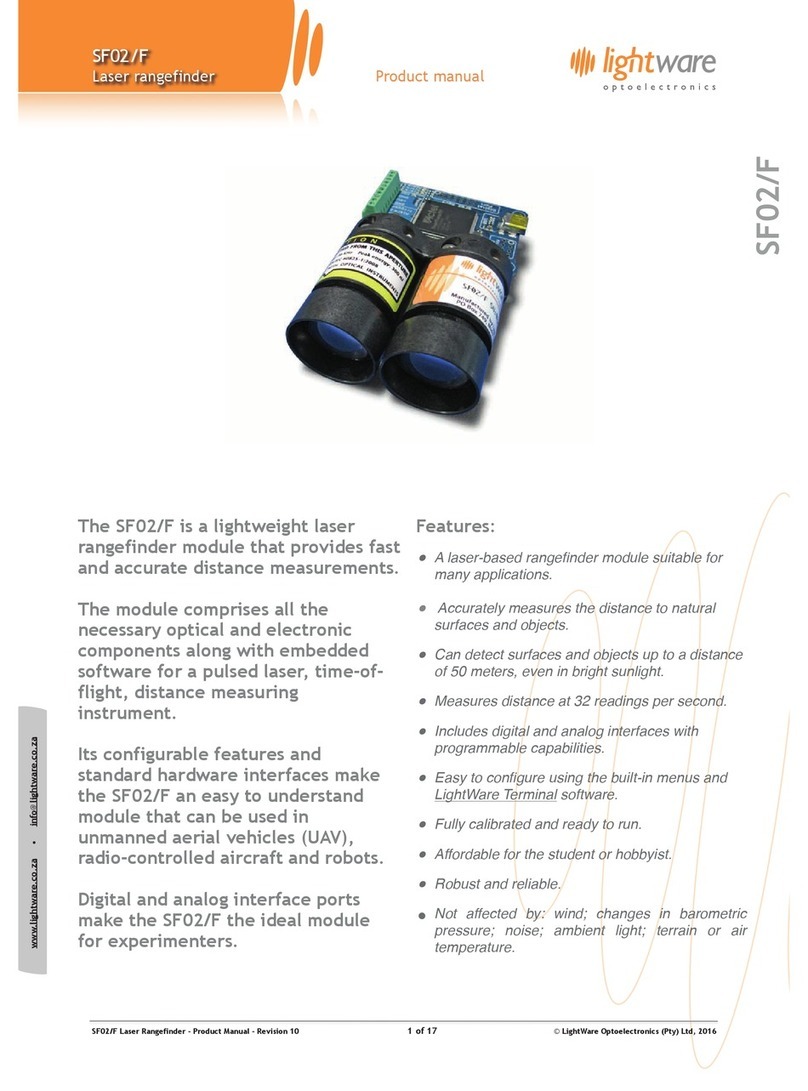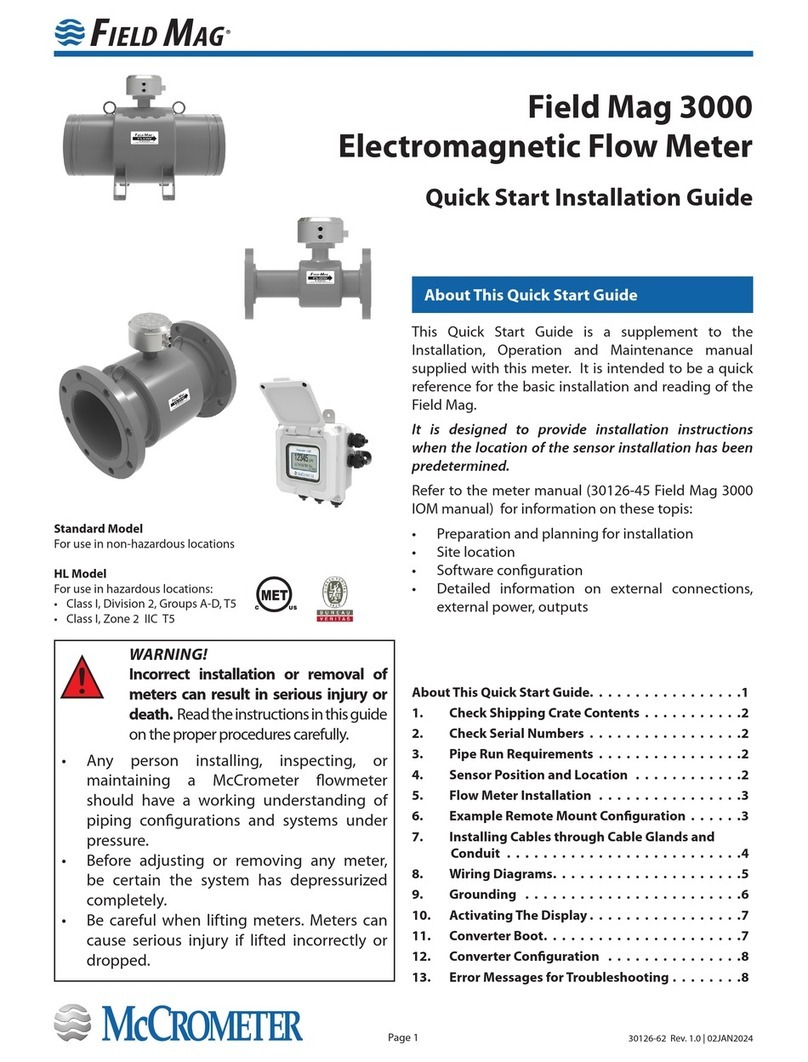SICK MAIHAK MaihakMBA 200 User manual

Analyzers and Process Instrumentation
OPERATING INSTRUCTIONS
Installation
Operation
Maintenance
MaihakMBA 200
Rotating Bin-Level Indicator
Title

Bin-level Indicator MaihakMBA 200
MaihakMBA 200 Operating Instructions 8 011 417/2006-02 (V1.2)©SICKMAIHAKGmbH
2
Document information
Document ID
Title: Operating Instructions MaihakMBA 200
Order No.: 8 011 417
Version: 1.2
Stand: 2006-02
Subject
Product name: MaihakMBA 200
Hardware: all versions
Manufacturer
SICK MAIHAK GmbH
Nimburger Str. 11 · 79276 Reute · Germany
Phone: +49 7641 469-0
Fax: +49 7641 469-11 49
E-Mail: info.sick-mai[email protected]
©SICK MAIHAK GmbH. All rights reserved.
Explanation of warning symbols
Warning levels
CAUTION
Hazard or unsafe practice which could result in personal injury or
property damage.
WARNING
Risk or hazardous situation which could result in severe personal
injury or death.
Explanation of information symbols
Contents
1Productoverview. . . . . . . . . . . . . . . . . . . . . . . . . . . . . . . . . . . 3
2 Product description . . . . . . . . . . . . . . . . . . . . . . . . . . . . . . . . 4
2.1 Unit components . . . . . . . . . . . . . . . . . . . . . . . . . . . . . . . . . . . . . . . 4
2.2 Principle of operation . . . . . . . . . . . . . . . . . . . . . . . . . . . . . . . . . . . 4
2.3 Optional equipment . . . . . . . . . . . . . . . . . . . . . . . . . . . . . . . . . . . . . 4
2.4 Appropriate use . . . . . . . . . . . . . . . . . . . . . . . . . . . . . . . . . . . . . . . . . 4
3 Installation . . . . . . . . . . . . . . . . . . . . . . . . . . . . . . . . . . . . . . . . . . 5
3.1 Protective roof / deflector . . . . . . . . . . . . . . . . . . . . . . . . . . . . . . . 5
3.2 Assembly (if required) . . . . . . . . . . . . . . . . . . . . . . . . . . . . . . . . . . . 5
3.3 Installation . . . . . . . . . . . . . . . . . . . . . . . . . . . . . . . . . . . . . . . . . . . . . 6
3.3.1 Operational conditions . . . . . . . . . . . . . . . . . . . . . . . . . . . . . . . 6
3.3.2 Installation position . . . . . . . . . . . . . . . . . . . . . . . . . . . . . . . . . . 6
3.3.3 Attachment . . . . . . . . . . . . . . . . . . . . . . . . . . . . . . . . . . . . . . . . . . 6
3.3.4 Temperatures of the distance tube . . . . . . . . . . . . . . . . . . . . 7
3.4 Electrical connection . . . . . . . . . . . . . . . . . . . . . . . . . . . . . . . . . . . . 7
3.4.1 Important safety notes . . . . . . . . . . . . . . . . . . . . . . . . . . . . . . 7
3.4.2 Protection against explosion . . . . . . . . . . . . . . . . . . . . . . . . . . 7
3.4.3 Type 210 (230 VAC) . . . . . . . . . . . . . . . . . . . . . . . . . . . . . . . . . . 8
3.4.4 Type 220 (24 VAC/DC) . . . . . . . . . . . . . . . . . . . . . . . . . . . . . . . 8
3.4.5 Type 230 (42/115/230 VAC) . . . . . . . . . . . . . . . . . . . . . . . . . 9
3.5 DIP switch settings for type 220/230 . . . . . . . . . . . . . . . . . . . 9
3.6 Closing the housing . . . . . . . . . . . . . . . . . . . . . . . . . . . . . . . . . . . . . 9
3.6.1 Closing the cable glands . . . . . . . . . . . . . . . . . . . . . . . . . . . . . . 9
3.6.2 Closing the cover . . . . . . . . . . . . . . . . . . . . . . . . . . . . . . . . . . . . . 9
4 First Start-up . . . . . . . . . . . . . . . . . . . . . . . . . . . . . . . . . . . . . . . 10
4.1 Switching on . . . . . . . . . . . . . . . . . . . . . . . . . . . . . . . . . . . . . . . . . . 10
4.2 Function test at first start-up . . . . . . . . . . . . . . . . . . . . . . . . . . . 10
4.2.1 Check the operative function . . . . . . . . . . . . . . . . . . . . . . . . 10
4.2.2 Check for triggering by the bulk material . . . . . . . . . . . . . 10
5 Maintenance . . . . . . . . . . . . . . . . . . . . . . . . . . . . . . . . . . . . . . . 10
5.1 Recommended maintenance work . . . . . . . . . . . . . . . . . . . . . 10
5.2 Preventive function check . . . . . . . . . . . . . . . . . . . . . . . . . . . . . . 10
5.3 Safety information on opening . . . . . . . . . . . . . . . . . . . . . . . . 10
5.4 Removing the unit head (repair note) . . . . . . . . . . . . . . . . . . . 10
6 Fault indication . . . . . . . . . . . . . . . . . . . . . . . . . . . . . . . . . . . . 11
7 Specifications . . . . . . . . . . . . . . . . . . . . . . . . . . . . . . . . . . . . . . 11
ATEX certificate. . . . . . . . . . . . . . . . . . . . . . . . . . . . . . . . . . . . . 12
Hazard (general)
Hazard by voltage
Hazard in explosion-hazardous locations
Hazard by high temperature or hot surface
Technical risk for this device or its function (general)
Technical risk for this device by voltage
or other electrical hazards
Supplementary information
Nice to know

Bin-level Indicator MaihakMBA 200
MaihakMBA 200 Operating Instructions 8 011 417/2006-02 (V1.2)©SICKMAIHAKGmbH 3
1
Product overview
200 °C
350 °C
200 °C
80 °C
800 °C
500 °C
80 °C
ATEX
Zone 20/21
(Option)

Bin-level Indicator MaihakMBA 200
MaihakMBA 200 Operating Instructions 8 011 417/2006-02 (V1.2)©SICKMAIHAKGmbH
4
2
Product description
2.1 Unit components
3. Shaft: Connects the paddle to the unit head. Various
lengths available (large sizes divided in two sections)
and a flexible steel cable as the shaft.
4. Paddle: Stops the shaft rotation when the bulk material
surrounds the paddle. Solid/flexible/foldable versions
available with different size or material.
5. Protective tube (option): Covers the shaft inside the
container. Various lengths available. Versions: open tube
for vertical mounting (great lengths delivered in two
sections); tube for horizontal mounting with additional
shaft bearing at the end; angled shaft bearing with
horizontal tube and a vertical shaft.
2.2 Principle of operation
The electric motor in the head makes the shaft and the
paddle rotate slowly. When the bulk material surrounds the
paddle, the rotation is blocked. The counter-torque is used
to turn the motor mechanism against a switch which then
turns the motor off. The switch has a second contact
(potential-free) which is used for the status indication.
As soon as the bulk material releases the paddle again, a
spring pulls the motor mechanism back into the working
position. Thus the switch is released and the paddle starts
rotating again.
2.3 Optional equipment
General options
●Special seal (DTR): Protection against gases, vapours,
and abrasive bulk materials.
●Compensating membrane: Membrane which allows
diffusion of water-vapour and thus can balance out the
humidity inside the unit head. Moreover, the membrane
will burst if the pressure inside the unit head increases
strongly due to operational trouble, which allows the use
on containers with an internal pressure up to +1MPa
(option »10 bar«).
●Heating in the unit head: Allows ambient temperatures
down to –30 °C.
●Height adjustment: A clamping sleeve which guides the
protective tube of the extension arm and allows fixating
the extension arm at variable insertion depth.
Electronic options (only for type 220 and 230)
●Action monitoring: A Hall sensor in the unit head
monitors the shaft rotation. The error status is indicated
by means of a relay contact.
●Indicating LED light: Indicates the current status.
2.4 Appropriate use
Range of application
MaihakMBA bin level indicators are rugged
electromechanical sensors, designed to detect the
presence of bulk material at the place of installation and
thus to control the filling of bulk material containers.
Possible applications depend on the configuration of the
individual unit.
Design options
Variable design features are, for example:
●Paddle design, size, and material
●Shaft design and material
●Sealing of shaft against enclosure
The corresponding properties for the unit can expand or
restrict the range of possible applications (e.g. suitability for
a particular type of bulk material). Please note carefully the
specifications for your particular unit.
Specifications on the nameplate
●Unit type (for example, »210«) and version code
●Required mains power supply (for example, »230VAC
50/60 Hz«)
●Explosion protection class (for example, »II 1D …«),
including the enclosure protection class (for example,
»IP 65«) and maximum surface temperatures:
– The first temperature value applies to the unit head.
– The second temperature value applies to the
components protruding into the container.
●Allowable ambient temperature (Ta) and »Ex« zone (for
example, »Z20«):
»extern« = for the unit head
»intern« = for components protruding into the container
Exemplary nameplate:
1. Unit head: contains the motor
drive and electronic components.
Three different types available.
2. Process connection: thread or
flange. Attached to the outer wall of
the bulk materials container. Holds
the unit head on the outside and
the protective tube (if provided) on
the inside. Many versions available
for individual adaptation to the
actual container.
1
2
3
4
5
WARNING: Explosion hazard
An MaihakMBA bin level indicator may only be used in
explosion-hazardous locations if the individual
specifications of the unit allow this.
b
Check nameplate and accompanying papers.
b
Check whether the specifications of the ATEX
certification must be complied with (→page 12).
CAUTION: Risks from inappropriate use
b
MaihakMBA bin level indicators are only to be installed
and put into operation by technicians who are suitably
qualified to carry out such work and are aware of the
possible dangers.
b
In addition to this manual, make sure that all local
regulations, technical rulings and internal-company
instructions that are valid at the place of use are
complied with.
b
Use the MaihakMBA bin level indicator only as it is
described and specified in this manual. Otherwise the
manufacturer’s warranty is no longer valid, and the unit
could be hazardous in use.
MaihakMBA 210 YAA1N1A00300AX
Maihak AG D-22399 Hamburg Made in Germany
II 1D IP65 T98°C/T98°C
TÜV 03 ATEX 2275 X
0032
QA
SN 654321 05.03
PN 214000-G 123456
230VAC 50/60Hz 10VA TaZ20/intern: –30°C... +80°C
TaZ20/extern: –15°C... +60°C

Bin-level Indicator MaihakMBA 200
MaihakMBA 200 Operating Instructions 8 011 417/2006-02 (V1.2)©SICKMAIHAKGmbH 5
3
Installation
3.1 Protective roof / deflector
b
If at all possible, place the MaihakMBA unit in a position
where falling bulk material will not directly strike onto the
shaft or the paddle.
For heavy bulk materials that could damage the shaft or
the paddle:
b
If required, install a stable deflector or protective roof in
the container which protects the shaft and the paddle
against direct impact of falling bulk material.
If the bulk material is heavy or can form large clumps:
b
Install a stable protective roof within the container to
shield the shaft (and the extension arm) from the weight
of the bulk material.
b
Provide sufficient space between protective roof and
paddle to make sure that the bulk material can reach the
paddle.
3.2 Assembly (if required)
If shaft, paddle, and protective tube (if provided) were
shipped dismantled (for safe and easy transport):
b
Install the shaft: Guide the top end of the shaft into the
shaft sleeve of the unit head. Use a split-pin to connect
both parts (push it through and spread it out). – With
two-part shafts: Join both parts of the shaft in the same
way.
b
Assembling the protective tube (for divided protective
tubes): Take the locking screws out of the connecting
coupling sleeve. Screw one of the protective tube parts
into the coupling sleeve – up to about the middle of the
coupling sleeve. Then screw-in the other part from the
other side and firmly attach both parts of the protective
tube. – Recommendation: Now make two small
countersunk holes in the coupling sleeve, which will fix
the position of the locking screws (use a max. 3.2 mm
diameter drill guided through the screw holes of the
coupling sleeve). – Put in the locking screws and tighten.
b
Install the protective tube (for units with a protective
tube): Apply a threadlocking adhesive (such as »Loctite«)
to the thread of the protective tube and screw the
protective tube into the threaded sleeve, as far as it
goes.
b
Shortening the flexible cable shaft (if required): Remove
the tensioning weight from the end of the cable (undo
the locking screw and pull out the cable). At the place
where the cable must be cut, wrap some adhesive tape
firmly around the cable, to protect against wire particles
shooting from the cable. Wear protective goggles/
glasses. Then cut the cable with a suitable wire cutter or
a cutting disk. Remove the adhesive tape and attach the
tensioning weight again.
b
Install the paddle: Guide the flat end of the paddle into
the slot of the shaft and attach it with the split-pin
provided (push it through and spread it out).
b
Do not remove, add, or change any of the components
in the instrument unless these changes are described
and specified in a manufacturer’s official information.
Otherwise the manufacturer’s guarantee becomes invalid,
and the certification for use in explosion-hazardous
locations (if provided) is no longer valid.
1 … 7 = order of assembly
●It may be necessary (or advantageous) to install the
paddle at the very end of the installation procedure.
●Recommendation: Apply a threadlocking adhesive
(such as »Loctite«) to all the locking screws.
1.
3.
2.
2.
5.
4.
1
2.
3.
6.
7.
1.

Bin-level Indicator MaihakMBA 200
MaihakMBA 200 Operating Instructions 8 011 417/2006-02 (V1.2)©SICKMAIHAKGmbH
6
3.3 Installation
3.3.1 Operational conditions
b
Observe temperature specifications on the nameplate
(explanations →page 4, § 2.4).
b
Keep the following pressure limits:
3.3.2 Installation position
b
Units without additional shaft bearing in the extension
arm: Use only with a vertically suspended shaft (±5°).
Exception: If the shaft is rigid (not flexible) and not longer
than 200 mm and the bulk material is light-weighted, an
angle of inclination of max. 90° is permissible (allows side-
mounting with horizontal shaft).
b
In case of lateral installation (horizontal shaft): Install
the unit in such a way that the cable glands are on the
underside of the housing.
The unit head can be turned (2) after the clamping screw (1)
on the underside has been released.
3.3.3 Attachment
Standard versions
b
Attach the MaihakMBA process connection to the
container.
b
If protection class IP 65 is required (European standard
EN 60529): Provide a suitable water/dust sealing
between MaihakMBA and container.
b
If the paddle does not go through the container
opening: Detach the paddle before mounting and re-
install after mounting.
Height adjustment (option)
The height adjustment device is a clamp-ring fitting which
allows to fix the protective tube at variable insertion depth.
1. Install the threaded base part of the fitting in the
container wall.
2. Put the clamping nut and the clamping ring over the
protective tube.
3. Guide the protective tube through the base part of the
fitting (caution: do not damage the sealing rings inside
the fitting) and bring it into the desired position.
4. Guide the clamping ring into the fitting. Screw-up and
tighten the clamping nut.
5. Install the paddle.
Temperature protection by height adjustment
The height adjustment device can also be used to keep the
unit head away from high container temperatures.
●Important: This feature applies only to units equipped
with »DTR« type bearings.
Mounting instructions:
b
Adjust the height to a level where the distance between
unit head and container is at least 200 mm (7.9").
b
If the container is equipped with a thermal insulation:
Remove the thermal insulation around the protective
tube, as describe in § 3.3.4 (→page 7).
When these conditions are kept, the unit can be used with
container temperatures up to 200 °C (392 °F).
Standard configuration –50 … +300 kPa
(–0.5…+3.0bar)
Version D10 (equipped
with burst membrane in
the unit head)
max. 1.0 MPa (10 bar)
In explosion-hazardous
locations
80 … 110 kPa
(0.8 … +1.1 bar)
The clamping screw must be fixed to achieve operational
condition.
m
a
x
.
9
0
°
max. 200
1
2

Bin-level Indicator MaihakMBA 200
MaihakMBA 200 Operating Instructions 8 011 417/2006-02 (V1.2)©SICKMAIHAKGmbH 7
3.3.4 Temperatures of the distance tube
Unit versions for high container temperatures above 80 °C
are equipped with a distance tube between unit head and
connection thread/flange. The purpose of the distance tube
is to keep high temperatures away from the unit head (max.
60 °C).
b
If the container is equipped with a thermal insulation:
Keep the distance tube free of thermal insulation, in
order to allow cooling by the ambient air. Do not cover
the distance tube with the insulation of the container.
Otherwise distance tube will not provide the required
cooling effect. Overheat can cause malfunctions and
damage the unit head.
3.4 Electrical connection
3.4.1 Important safety notes
3.4.2 Protection against explosion
b
Certification: Check if the individual unit is applicable to
the use in the actual explosion-hazardous location (see
nameplate and delivered documents).
b
Equipotential connection: In addition to the protective
earth connection (PE), install an equipotential bonding,
using the terminal on the outside of the unit head.
b
Cables: Use only cables which fit to the cable glands. For
MaihakMBA standard versions, the outer diameter of
the cables must be 6 … 12 mm.
b
Cable glands: The built-in cable glands may only be
replaced by components which are certified for the use
in the actual explosion-hazardous location (ATEX-
certified).
b
Fixed installation: Fix all connected cables in place over
their entire length.
b
Sparks: Prevent generation of sparks inside the
container. Sparks can be generated when the shaft or
the paddle collides with metal parts. If the MaihakMBA
is equipped with a flexible shaft, sparks could be
produced when the shaft cable swings and the paddle
collides with the container wall.
b
Installation standard: Make the installation in
accordance to the European standard EN 50281-1-2
(»Electrical apparatus for use in the presence of
combustible dust«, part 2; identical to IEC 61241-1-2).
WARNING: Risk of injury
The distance tube is possibly hot enough to burn skin
immediately when being touched.
b
If the container is hot: Protect the distance tube
against accidental touching.
WARNING: Explosion hazard by dust contamination
The surface temperature of the distance tube can be
significantly higher than the unit head temperature.
b
Check if the dust-explosion limit value can be exceeded
when the surface of the distance tube is covered with
dust.
b
If this hazard exists: Make sure that the distance tube
cannot be contaminated with dust, or that the distance
tube is periodically cleaned as a preventive measure.
The motor mechanism requires approximately 3 seconds to
indicate stopping or restarting of the paddle (switching
delay due to the mechanical sequence).
Additional indication delay can be effected by
●the characteristics of the bulk material
●torsion effects (e.g. cable shaft, rubber paddle)
●electronic switching delay (→page 9, § 3.5)
WARNING: Free electrical contacts inside the unit head
Before opening the unit head, shut off the mains power
supply and all connected signal voltage. The electrical
circuits inside the unit head are not protected against
physical contact.
WARNING: High voltage inside the unit head (type 230)
In the type 230 unit head, there are always contacts with
an output of 230 and 115 V, even if the unit is powered
with a lower voltage (→page 9, § 3.4.5).
b
Observe this information when operating the unit with
open unit head for service purposes. Take care. Give a
warning to other persons.
Overvoltage can immediately destroy internal electronic
components. Carefully observe the mains voltage
specification on the nameplate.
WARNING: Explosion hazard
If the unit is used in an explosion-hazardous location,
the following criteria must be observed:

Bin-level Indicator MaihakMBA 200
MaihakMBA 200 Operating Instructions 8 011 417/2006-02 (V1.2)©SICKMAIHAKGmbH
8
3.4.3 Type 210 (230 VAC)
Signal contact
b
Use the potential-free make&break relay contact K1 for
the level indication.
Depending on setting of S1, relay K1 is activated either
when the paddle is rotating or when the paddle is stopped.
b
Select which setting provides a fail-safe operation in your
system:
Status output
S3 switches the power voltage (L1) between terminal 4 and
5, directly actuated by the motor mechanism.
Permissible contact load
Directcurrent: 60VDC,1A(DC1)
Alternating current: 250 VAC, 2 A (AC 15)
Power supply
Permissible power supply voltage: 230 VAC –15 %/+10 %
b
Provide an external power fuse (recommended rating:
1 A). Connect the power supply to terminals L1 and N on
the electronics board.
b
Connect the protective earth (PE) conductor to the
terminal in the unit head.
Overheat fuse
Type 210 is equipped with an overheat fuse which cuts off
the power supply when the internal temperature exceeds
98 °C (208 °F). When the fuse is blown, the electronics
board needs to be replaced for repair.
Wiring example as FULL level indicator
3.4.4 Type 220 (24 VAC/DC)
Signal contact
Use make&break relay contact K1 for the level indication
(paddle rotating / stopped). Depending on setting of S1-1,
relay K1 is activated either when the paddle is rotating or
when the paddle is stopped.
b
Select which setting provides a fail-safe operation in your
system (→§3.5).
Status contact
Relay contact K2 is used to indicate a fault condition. Full
information →page 11, § 6.
Permissible contact load
Direct current: 60 VDC, 1 A (DC 1)
Alternating current: 250 VAC, 2 A (AC 15)
Power supply
Permissible power supply voltage:
Direct current: 24 VDC –10 %/+30 %
Alternating current: 24 VAC –15 %/+10 %
b
Provide an external power fuse.
b
Connect the power supply to terminals »24 V« (+) and
»0 V« (–).
b
Connect the protective earth (PE) conductor to the
terminal in the unit head.
Power overload fuse
The power overload fuse cuts off the internal power supply
in case of high current.
b
When overload fuse has been released: Switch off the
power supply externally and wait for approximately one
minute for the fuse to cool down; then switch on the
power supply again.
b
If the overload fuse is released again: Search for the
trouble; or replace the electronics board, if required.
Overheat fuse
The overheat fuse cuts off the power supply when the
internal temperature exceeds 98 °C (208 °F). When this
fuse is blown, the electronics board needs to be replaced
for repair.
Position H Position L
S1 Fail-safe FULL level
indication:
K1 is activated when the
paddle is rotating.
During power failure, the
»full« status is indicated
(like paddle is stopped).
Fail-safe EMPTY level
indication:
K1 is activated when the
paddle is stopped.
During power failure, the
»empty« status is
indicated (like paddle is
rotating).
12 5PE 3NL1
230 VAC
4
S1
S3
K1
S2
S1
HL
Signal
HL
210
MaihakMBA
mech.
Status
Stop
Rotat.
L1
98 °C
12
3
N
L1
210
MaihakMBA
L1
N
H
S1
K1
fill control
PE
123 456240
24 VDC
24 VAC
Signal
K1 K2
AC/DC
stab.
98 °CPTC
24 V
0 V
S1
3412
OFFON
S2 μC
Status
220
MaihakMBA

Bin-level Indicator MaihakMBA 200
MaihakMBA 200 Operating Instructions 8 011 417/2006-02 (V1.2)©SICKMAIHAKGmbH 9
3.4.5 Type 230 (42/115/230 VAC)
Signal contact
b
See type 220.
Status contact
b
See type 220.
Permissible contact load
b
See type 220.
Power supply
b
Provide an external power fuse.
b
For 115 or 230 V power voltage: Connect L1 conductor
to terminal »115« or »230«, respectively. Connect N
conductor to terminal »N«.
b
For 42 V power voltage: Connect L1 conductor to
terminal »42«. Connect N conductor to terminal »0«.
b
Connect the protective earth (PE) conductor to the
terminal in the unit head.
Internal fuses
Type 220 is equipped with three internal fuses:
●Power overload fuse: see type 220.
●Overheat fuse: see type 220.
●Overheat fuse in the power transformer: cuts off the
transformer circuit at 98 °C (208 °F).
3.5 DIP switch settings for type 220/230
3.6 Closing the housing
3.6.1 Closing the cable glands
b
Lay the connected cables internally in such a way that
they do not interfere with the mechanism.
b
After the cables have been installed, the cable glands
must be closed-off to be dust-tight and spray-water
resistant.
b
Unused cable glands must either be blocked-off with
stoppers or replaced with closing caps. If used in
explosion-hazardous locations, these parts must be
applicable to explosion-hazardous locations (ATEX-
certified).
3.6.2 Closing the cover
b
Before closing cover of the unit head, check whether
there are any foreign bodies inside the unit head (such
as rests of cable). Remove them.
b
Visually check the sealing of the cover. Clean or replace
if necessary.
b
Put the cover in place and screw it up tight.
WARNING: Internally generated power voltage
The power terminals »230« and »115« will have a voltage
output of 230/115 V, even if the unit is used with a lower
power voltage (due to power feedback through internal
transformer).
b
Observe this information when operating the unit with
open unit head for service purposes. Take care. Give a
warning to other persons.
Permissible power voltage tolerance: –15 %/+10 %
98 °C
K1 K2
230 N12
3456115 42 0
98 °CPTC
24 V
0 V
S1
230 / 115
VAC
42
VAC
Signal
98 °C
3412
OFF
S2
PE
ON
Status
230
MaihakMBA
AC/DC
stab.
μC
S1 ON OFF
1Fail-safeFULLindication:
K1 is activated when the
paddle is rotating. During
power failure, the »full«
status is indicated (like
paddle is stopped).
Fail-safe
EMPTY indication: K1 is
activated when the
paddle is stopped. During
power failure, the »empty«
status is indicated (like
paddle is rotating).
2Switch-ondelay:K1
switches on with a delay
of 4 s.
No electronic switch-on
delay.
3Switch-offdelay:K1
switches off with a delay
of 4 s.
No electronic switch-off
delay.
4 The action monitoring
option is built-in
(consequences
→page 11, »Fault
indication«).
The action monitoring
option is not built-in.

Bin-level Indicator MaihakMBA 200
MaihakMBA 200 Operating Instructions 8 011 417/2006-02 (V1.2)©SICKMAIHAKGmbH
10
4
First Start-up
4.1 Switching on
4.2 Function test at first start-up
4.2.1 Check the operative function
After the first start-up, check the indicating function:
1. Allow the paddle to rotate freely: check the »empty«
indication.
2. Stop the paddle by hand: check the »full« indication.
4.2.2 Check for triggering by the bulk material
Procedure
b
While visually watching the bulk material level, fill and
empty the bulk materials container up to the
MaihakMBA unit, and check that the indicating function
is correctly triggered. This test should be made several
times.
b
If the MaihakMBA unit does not correctly indicate the
level status: Check the options for mechanical
adaptation (see below) and carry them out if necessary.
Possible ways of adapting the unit
●Spring tension (see figure):
– More sensitive setting (less tension), for light bulk
material: Bring the spring to closer position.
– Less sensitive setting (more tension), for heavy bulk
material: Bring the spring to a more distant position.
●Paddle size:
– To make it more sensitive (for lighter bulk material):
Install a bigger paddle.
– To make it less sensitive: Install a smaller paddle.
●Spring type: If required, install a stronger or weaker
spring (3 different types available).
5
Maintenance
5.1 Recommended maintenance work
b
Clean the moving external parts: Clean off deposits and
dirt on paddle and shaft, using a (soft) scraper and/or a
brush. Do not use force. Caution: Do not damage the
shaft sealing. Do not allow bristles to get between the
shaft and the shaft sealing.
b
Inspect the parts subject to wear (highly recommended
in case of abrasive bulk material): Make a visual
inspection of the parts which protrude into the container
(shaft, paddle, etc.). Pay special attention to the
connecting parts (split-pins, etc.). Replace damaged or
dubious parts.
b
Clean the protective tube (only if the unit is equipped
with an open protective tube): Clean the inside of the
protective tube to make sure that the shaft can always
freely rotate.
b
Clean the distance tube (if existing – if required for
explosion protection →page 7, § 3.3.4): Remove dust
contamination from the distance tube.
5.2 Preventive function check
If the indicating function is seldom triggered during
operation (e.g. if the level indicator is used as a safety
switch):
1. Inform the connected stations that a test will be carried
out.
2. Stop the paddle by hand / allow the paddle to rotate
freely, and check the correct status indication.
5.3 Safety information on opening
5.4 Removing the unit head (repair note)
The unit head can easily be separated from the process
connection, without opening the process connection:
1. If the unit head is to be removed completely, disconnect
the electric cables first.
2. Loosen the fixing screw on the underside of the unit
head for approximately 3 mm (3 … 4 turns).
3. Carefully pull the unit head from the process connection
(along the direction of the shaft). This requires some
strength, due to adhesion and friction of the sealing: use
skilful power, but no brutal force; protect yourself against
tumbling and falling in the case that the unit head goes
suddenly free.
Re-assembly is made in reverse order.
WARNING: Health risk / Explosion hazard
During operation, the unit head and the cable gland(s)
must be correctly closed and sealed. Otherwise the
specified type of protection and the specified explosion
protection (option) is not guaranteed.
If the type of bulk material has been changed:
b
Do this test/adaptation again.
WARNING: Health risk / Explosion hazard
b
Before opening the unit head: switch-off the power
supply and any connected signal voltage at an external
point. (Note: the level indication is thereby disabled.)
b
Only open the housing when you are absolutely sure
that there is no possible danger.
WARNING: High voltage inside the unit head (type 230)
In the type 230 unit head, there are always contacts with
an output of 230 and 115 V, even if the unit is powered
with a lower voltage (→page 9, § 3.4.5).
b
Observe this information when operating the unit with
open unit head for service purposes. Take care. Give a
warning to other persons.
Severe dirtiness inside the unit head can affect the proper
functioning of the unit.
b
Protect the inside of the unit head from getting dirty.

Bin-level Indicator MaihakMBA 200
MaihakMBA 200 Operating Instructions 8 011 417/2006-02 (V1.2)©SICKMAIHAKGmbH 11
6
Fault indication
Operation principle of the fault status indication
MaihakMBA type 220 and 230 are equipped with the
»Status« switch contact for fault indication, which is driven
by relay K2. During normal operation, K2 is activated; in
case of an internal fault, K2 is deactivated. This also
happens during power supply failure. Please note: In fault
condition, also relay K1 (which drives the »Signal« contact)
is deactivated, in order to provide a fail-safe operation;
however, this is only achieved if the K1 function mode is
properly selected (→page 9, § 3.5)
Fault indication caused by action monitoring
If action monitoring is built-in (option), the following
conditions will trigger the fault status indication:
– The shaft does not rotate, although the motor is not in
the stop position (switch S2).
Possibly defective: switch S2, motor, rotation sensor.
– The shaft is rotating, although the motor is in the stop
position (switch S2). – Possibly defective: switch S2.
b
Remedy: Check if internal micro-switches are blocked.
b
If this does not help: Replace the unit head.
General causes for fault indication
Without the action monitoring option, the following
conditions will trigger the fault status indication:
●Power supply has failed.
●An internal fuse is defective.
●Action monitoring is activated although it is not built-in.
Remedy: Correct the setting of S1-4 (→page 9, § 3.5).
7
Specifications
Mains voltage: see nameplate
Tolerance: see text in this manual
AC mains frequency: 50 … 60 Hz
Response time: 3 s
– quick-rotating version: 0,6 s
Power consumption
– without heating: 3 VA
– with heating: 10 VA
Ambient temperature outside the container
– without heating: –15 … +60 °C (5 … 140 °F)
– with heating: –30 … +60 °C (–22 … +140 °F)
Allowable temperature inside the container
– standard versions: –30 … +80 °C (–22 … +176 °F)
– special versions: see nameplate
Dimensions: see figure below
125L118
58
28
160
29
48
G1½"
33.2
A
125
220L
70
60
D
L178
41
D
33.2
ABCD
mm
210 170 18 16
220 180 18 20
240 200 18 18
250 210 18 22
228.6 190.5 19
DN 100 PN 6
DN 100 PN 16
DN 125 PN 6
DN 125 PN 16
4" ANSI Class 150
5" ANSI Class 150 254.5 215.9 22.2
C
B
105
135
L: Immersion depth

Bin-level Indicator MaihakMBA 200
MaihakMBA 200 Operating Instructions 8 011 417/2006-02 (V1.2)©SICKMAIHAKGmbH
12
ATEX certification, page 1 of 3

Bin-level Indicator MaihakMBA 200
MaihakMBA 200 Operating Instructions 8 011 417/2006-02 (V1.2)©SICKMAIHAKGmbH 13
ATEX certification, page 2 of 3

Bin-level Indicator MaihakMBA 200
MaihakMBA 200 Operating Instructions 8 011 417/2006-02 (V1.2)©SICKMAIHAKGmbH
14
ATEX certification, page 3 of 3

Bin-level Indicator MaihakMBA 200
MaihakMBA 200 Operating Instructions 8 011 417/2006-02 (V1.2)©SICKMAIHAKGmbH 15
Notes

Analyzers and Process Instrumentation
SICK MAIHAK worldwide
You will find our local subsidiary
or agency at:
www.sick-maihak.com
8 011 417/2006-01 (V1.2)
SICK MAIHAK GmbH |Analyzers and Process Instrumentation
Nimburger Str. 11 |79276 Reute |Germany |www.sick-maihak.com
Your local sales and service partner
MaihakMBA 200
Table of contents

